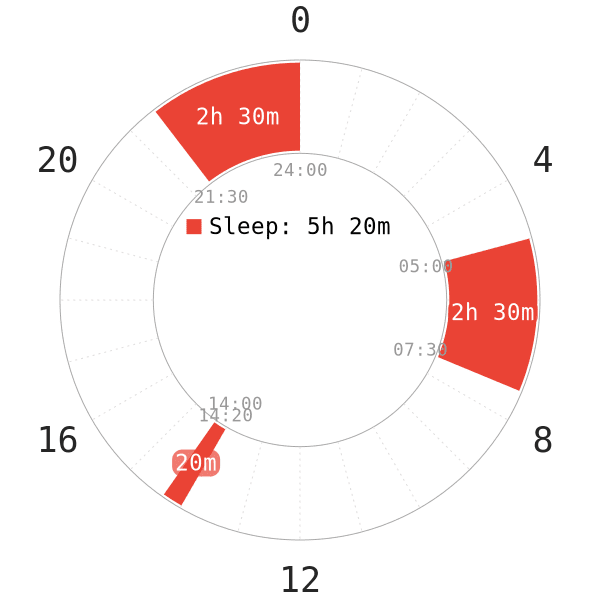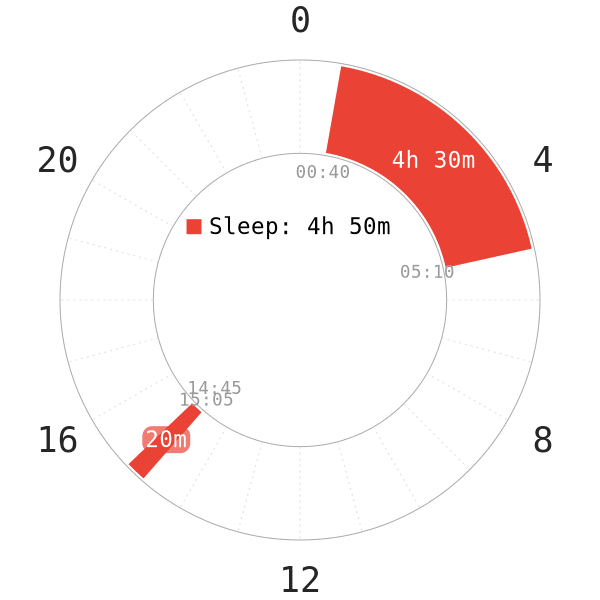Introduction
This is a continuation of Scheduling Introduction in case none of the standard sleep schedules suit your needs. Some concepts in this article are more advanced; thus, some can be a bit more experimental. Nevertheless, it is worth reading through this section when designing a schedule.
Advanced Scheduling
Strongly Rotate Your Circadian Rhythm
The more you move the sleep schedule with respect to the local day-night cycle, the less likely it is to overlap with the optimal times for the individual sleep blocks. This can become problematic due to insufficient sleep, which leads to chronic tiredness. This can be avoided by moving circadian rhythm along with your sleep schedule by traditional circadian cues. These include light, food, activity or even temperature.
The longer the relative shift and the shorter the total amount of sleep, the more cues need to be monitored to ensure a healthy circadian rhythm. Light management should always take place regardless if there is a schedule shift or not.
People should only use this as a last resort or if they have significant difficulty sleeping earlier, e.g. during SWS peak. Another example is having a third shift, which is also complicated.
Sleep Chronotype
The sleep chronotype can influence their choice in sleep schedules. This is because different chronotypes require different schedule groups in order to optimize work and adaptation. More information on how to determine chronotypes as well as their impact is in this blog post.
Splitting Naps
Most standard schedules suggest the nap lengths be 20 minutes long. However, splitting a 20-minute nap into two 15-minute naps is also possible. The naps should be at least 2 (preferably 3) hours away from any other naps.
- 15 minute naps are especially beneficial if there are scheduling difficulties present preventing the ability to reliably take a 20-minute nap.
- For example, someone has a 20-minute work break and needs to nap in their car. However, the travel time back and forth is a few minutes each way. A 15-minute nap could be useful here as well.
Some people might find natural wakes after around 10 to 15 minutes into a nap.
- The advantage for getting up here is the lack of sleep inertia, but the amount of REM sleep from the nap is smaller as a cost.
- To these people, if they start getting up at this time, they need to schedule additional naps to adapt due to the decreased amount of REM sleep from the shorter naps. The option to sleep in and finishing the nap at 20 minutes is often possible.
The reason why one 20-minute nap cannot split into two 10-minute ones is because of some light sleep at the beginning of every nap. To make up for this time, an additional 5 minutes is necessary to gain the same total amount of REM sleep as one 20-minute nap.
Protracted Naps (Pronaps)
The idea behind Pronaps is that napping at the right time of the day for longer than the usual 20 minutes is possible. These naps can also support more REM sleep and avoiding sleep inertia. Originally from Polyphasic Society, those authors suggested a longer first nap of 40m for people on Everyman 3 who felt they have greater sleep need.
In the Polyphasic Discord, user Jelte1234 independently further developed the idea as a 35-45m Pronap. This nap duration can suit any schedule that has a nap in the 6-9AM REM peak and a core of at least 2 cycles in the SWS peak.
Mechanics
If a nap is longer than 20 minutes, there is usually a high likelihood of entering SWS. This leads to rough wakes and possible oversleeps and sleepers should generally avoid them.
- By placing a nap in the REM peak, it is less likely to incur SWS wakes. Because of this, the nap can potentially be longer, which enables the opportunity for more REM sleep from a single nap. However, this will not work on nap-only schedules; SWS can creep into morning naps because there are no core sleeps.
- In order to minimize SWS pressure, sleepers should use a Pronap with a sufficiently long core around the ideal SWS peak. This is to ensure that all SWS requirements go into the core.
- Alternatively, two 20 minute naps could merge into a single Pronap after adaptation to a polyphasic schedule. This may prevent increasing SWS pressure; however, the specifics of this procedure and the necessary scheduling is unknown.
When to use
The Pronap is most useful on the Everyman schedules. Since the Dual core (excluding DC3 and DC4) and Tri Core schedules already have a core near the REM peak, there is usually no additional room for a nap there. It is also useful for schedules that already have a core long enough to fulfill all SWS requirements. For example, a 4.5-hour core sleep would do the job nicely.
Due to SWS pressure, a Pronap is not suitable for regular E3, E4, E5 or for nap-only schedules. These schedules’ core sleeps are not long enough to cover all daily SWS requirement.
Benefits
- Ensure sufficient daily REM
- Possibly improve the ease of a maximum gap after the first nap (e.g. 8 hours for E2 – yet to be shown)
- Allow greater schedule flexibility once adapted
- Even removing a later nap. A Pronap, however, did not seem to allow a wake period longer than 8 hours for E2 sleepers.
During adaptation, it is possible that a Pronap will occasionally result in an SWS wake. Therefore, it is important to remember that the repartitioning of sleep stages are still ongoing. Over time, it will sort itself out as adaptation progresses.
Schedule Modifications
When the standard schedule names do not fully describe certain changes, the following scheduling ‘modifications’ are applicable.


- Shortened: The length of a core sleep has reduced in comparison with the standard schedule by at least one sleep cycle. This greatly increases the difficulty of the schedule; in most cases, most people with average sleep needs cannot sustain it.
- Extended: The length of a core sleep has lengthened in comparison with the standard schedule by at least one sleep cycle. This can make the sleep schedule easier, accommodate for people with increased sleep needs (including teenagers) and allow for increased flexibility in nap timings after adaptation. The extension also provides more adequate recovery for continuous physical exertion, such as substantial exercising every day.
- Flipped: The schedules sleep blocks have shifted so that the night sleeps become daytime sleep and vice versa. People working during the night typically would attempt these scheduling variants.
- Modified: The standard schedule undergoes a fundamental change in structure. For example, a Dual core schedule with mid-cycle core durations. New polyphasic sleepers should not make fundamental modifications to tested schedules.
- Recovery: This is when someone is recovering from sleep deprivation after failing a schedule. They usually recover from sleep deprivation before re-attempting an adaptation. See Adaptation methods for more information.
These schedule modifiers often follow the abbreviated schedule names. Examples include “DC2-shortened”, “Mono-recovery”, “Siesta-shortened” and “E1-flipped”. These ways improve the descriptions of the schedules and facilitate discussion. So far, only the Polyphasic Sleep Discord server uses this standardized naming system.
Regardless, shortened schedules are mostly not sustainable for people with normal sleep needs. Modified schedules should be done with caution; there are usually reasons why the standard schedules are the way they are.
The other modifications are potentially more sustainable for more individuals. It is also very necessary to pay attention to flipped schedules. This is because of the increased difficulty in shifting and maintaining a flipped circadian rhythm.
Forbidden Zone of Sleep
The forbidden zone of sleep (FZS) is defined as a period of time of natural wakefulness right before the onset of nocturnal sleep. During this period, the body has a high tendency to resist sleep; thus, it is usually impossible to fall asleep. Under normal sleep conditions (based on normal nocturnal monophasic sleep and no sleep deprivation), FZS hours vary from 19:00 to 21:00 or 22:00…
Flexible Sleep Timing
This page is an expansion from the Advanced Scheduling Section on the concept of flexing sleep. The strategies of flexing sleep in this page are based on past experiences of successfully adapted polyphasic sleepers. As such, they are mostly experimental ideas with the hope of making polyphasic schedules flexible and adaptive to daily lifestyle. Being able to move polyphasic sleep blocks around is very appealing.
Additionally, if pulled off successfully, it will help polyphasic sleepers maintain their sleep schedules. This is especially beneficial if these sleepers have successfully adapted to their respective schedules and want to pursue the napping lifestyle in the long run.
Main author: Aethermind
Page last updated: 1 April 2021
